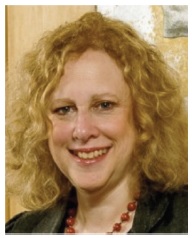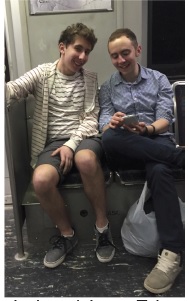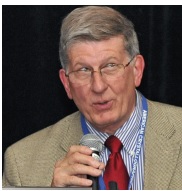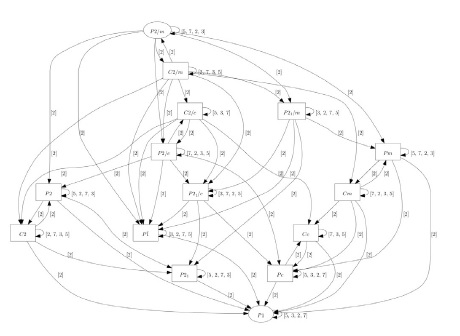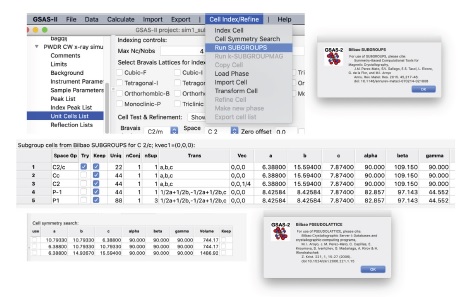- History Home
- People, Leadership & Service
- A Legacy of Excellence
- History & Impact
- Meetings Through the Years
- Resources
Biography - Brian H. TobyBiography | Publications | Curriculum Vitae | Videos | Slides | Articles | Obituary
2019 Trueblood AwardAs I was preparing to give this talk, being so honored by my professional peers with the Trueblood award, I thought about some of the lows and highs I have seen in this journey. I regularly speak with young scientists who are struggling with launching their careers – and I do believe it has gotten harder – but I want to hold out hope that the wonderful level of recognition that I am experiencing with this award is not reserved only for those who have charmed career trajectories, consisting of successive breakthroughs and recognitions. I have worked hard, but recognize that my career was driven as much by things I could not control. I have benefitted from chance opportunities and the kindness of mentors. This award talk provided an occasion where I could thank some of those people who influenced my career the most, though not everyone deserving, alas. Finally, I can’t give a talk without some science content and I used the lecture to talk about subgroups and supergroups and how that relates to getting structures right.
Sidney Toby and Frina Toby. So, launching into the people I wanted to thank, let me start with my parents. I did not grow up with much self-confidence, in part because I was a terrible student from early grades through high school (I even repeated 3rd grade). Nonetheless, each of my parents were very important in launching my interests in science. My father, 89 in May, is a retired physical chemistry professor from Rutgers who always enjoyed his work, had a constant interest in learning more and was willing to teach me how things work and how to fix things, both around home and occasionally in his lab. Having now raised children of my own, I admire his patience with “let me help daddy.” My favorite thing to do when in his charge as a child was sit in his lab doing glass blowing or wander around collecting the little beads of mercury that were scattered all about his lab into an empty squeeze bottle. (All contemporary safety officers are now shuddering.) My father was born in London and as a school child there experienced the very severe bombings of WWII. After a short post-war stint in the Royal Air Force, and an undergrad degree from Queen Mary College, he then came to McGill for his Ph.D., where he met my mother who was getting her B.A., also at McGill. My mother, who just turned 90, wanted to be a physician, but that was prevented by “kind” relatives who did not believe in educating women for a profession. She did enroll later to get a Ph.D. in biochemistry, when my sister and I were quite young. Our demands were no doubt partly responsible for her “flunking out with a masters.” Having trouble finding a job, but wanting to do something in science, she started volunteering in my father’s lab, where she initiated his group’s use of the Rutgers’ computer (yes, there was only one back then) for data analysis. From her I got my first exposure to computing. By the time I was in high school, I was writing programs and my mother was getting paid to teach Freshman Chemistry. In the talk I did note that my mother’s family fled from Romania just before WWII started. At the time, U.S. immigration policy strongly disfavored European Jews attempting to flee. Few imagined how bad it would actually become. Fortunately, Canada had much more open borders. Thanks to Canada, my mother’s family settled in Quebec, later moving to Montreal. What would have happened without Canada? I probably would not be around to say. My undergrad years were the first high-point in my life. As freshman (taking advantage of the Rutgers faculty brat discount), I was able to pick courses with subjects that I wanted to learn, and my grades surprised everyone – most of all me. Not mentioned in the talk was that my first publication to be written started from a dinner conversation where I suggested optimizing one of my mother’s APL programs (Toby, Toby and Toby, 1978, Int. J. Chem. Kinetics, 10, 417). Interestingly, my optimization there used the same multi-dimensional linear algebra strategy we now use with NumPy in GSAS-II.
Joseph Potenza. The summer after my freshman year, I went looking for a research job. Not so much because I expected to like it, but because I knew the salary would be low, but enough to get my parents off my back and besides if I was not paid that much I would not need to work that hard. Of the faculty I spoke to, crystallographer Joseph Potenza (himself a student of William Lipscomb) gave me the same tour of his labs that he would have given a prospective grad student, and I still remember his words, “if you choose to work here…” With just that I was sold. He was able to offer me that job because he paid me from a grant written by Harvey Schugar. Joe and Harvey ran a lab together and co-supervised students. Their lab changed my life. It was a fun group of people and we all enjoyed the research. Collaboration was the rule in Joe and Harvey’s group, both internally and with the rest of the department. I ended up as a coauthor on seven more papers, which included a total of seven Rutgers faculty members (not counting the Tobys).
Harvey Schugar. Joining the group that summer were two other 1st year undergrads, Bill Schwindlinger and Steve Rudich (now both M.D.-Ph.D.s). Sometime during that summer, the professor in charge of freshman chemistry, Lester Morss, totaled up the scores for the year and told us that out of ~800 students, Bill, I and Steve had scored 1, 2 and 3, respectively. Harvey jumped on that and Number-One, Number-Two,… became our nicknames -- until I did something dumb (no memory of what) and Harvey started calling me Two-Bar, which he still does. Remembering Lester, who I very much miss, brings to mind Dan Nocera, a fairly recent ACA Wood prize winner. Dan was a year ahead of me at Rutgers, and then worked for Lester and later joined Joe’s group to do magnetic spectroscopy. Dan was very impressive even back then. Crystallography just made sense to me and the work was a good match for my strengths and weaknesses (such as I’d rather spend a day coding to avoid an hour or two of tedious work). During that time, I got to know grad students Tim Fawcett, John Rose and Bill Furey; I’d like to think that my ORTEP previewer shaved months off their grad careers. I also taught myself digital electronics and PDP-8 assembly language from schematics and source code labeled in Dutch while troubleshooting a CAD-3 diffractometer, given up for dead, that Nonius would no longer service. There were cheers around the lab when I found and replaced the bad chip and the CAD-3 again worked, (but I was still Two-Bar). When pondering grad school, I accepted the advice I got, which was that it was hard to find a job in crystallography. That advice was partly correct. It was much harder back then than it had been a few decades earlier. The less said about my grad studies perhaps the better. Grad school was an amazing time of growth for me, but that cannot be said for my thesis work in surface science. I can now see the fraction of the blame that I own, but reminders of those days still bring on PTSD symptoms. Graduating, I did not see much value in myself as a scientist and I was happy to accept a job at Union Carbide, Inc. (Rest in Pieces) that suited my self-appraisal. Fortunately and unplanned by me, Carbide wanted me to learn more about powder diffraction, and sent me to work with David Cox at Brookhaven (who invented high-resolution synchrotron powder diffraction), just as the NSLS was coming on-line. I learned so much from Dave, but more importantly, I discovered that research was as fun there as it had been in my undergrad work. I finally knew what I wanted to do and that it was not going to happen at Carbide.
Dave Cox. Takeshi Egami, who I met as a user on Dave’s beamline, rescued me from Carbide with generous research associate and later lecturer positions at the University of Pennsylvania. I went planning to work on quasicrystals but instead got diverted to working on inventing PDF analysis techniques for studying local order in (the then brand-new) high-Tc superconductors. With Takeshi, I had the opportunity to return to NSLS, but also make many visits to IPNS at Argonne and even the ILL in Grenoble.
Takeshi Egami. I can categorically say that without the mentoring of Dave and Takeshi, I would not have become the scientist that I am now; I want to thank them so much. While working at Penn I went to my 1st ACA meeting and found my professional community. Also, while in Philadelphia, I met my wife and life-partner Diane Pies Toby. More on that later. Still, at that point in my career, I still did not see myself as being able to do academic-level science on my own and took a job at Air Products & Chemicals, Inc., which hired me to attack some cutting-edge powder crystallography problems. Despite my fears, I succeeded with them. It was a great place to work. I continued to do work at Dave Cox’s beamline, but APCI also sent me often to collect neutron data at the NIST Reactor, where I gained much from the very wise and experienced crystallography team of Judith Stalick, Tony Santoro and Ted Prince.
Judy Stalick, Tony Santoro, and Ted Prince. To my amazement, the NIST Reactor’s Science Director, the late Jack Rush, invited me to interview for the position created by Ted Prince’s retirement. Diane was willing to close her psychology private practice if I got that job, which is what happened. In retrospect, I would likely have stayed at APCI out of loyalty, if not for a rather needless layoff that occurred shortly before I interviewed. Such loyalty would have been quite misplaced. By now, I think every one of my coworkers from those days is no longer an APCI employee and many did not leave by choice.
Jack and NIST Reactor director, Mike Rowe, were benign despots; as a team leader I could not sign for a postage stamp, but both were also excellent managers and selfless in promoting all the good science and scientists at the superb facility. At NIST I finally started to see myself as a full-fledged scientist and I gained very much from the opportunity to work closely with Judy, from whom I also learned much. I cannot talk about my career and life journey without thanking my family. My wife Diane has been my partner in my career for about half my life now; I’d like to believe I have reciprocated. Diane is a Ph.D. psychologist who has made many sacrifices in aid of my career, including four moves that included three states (which required closing practices and retaking licensing exams.) Somehow on this journey we found ourselves joined by Jason (now 25), Josh (now 21) and our dog Rocky and each has added much to my life. My family provides me with a sense of internal security, drive and inner peace that helps me feel rooted in a way I have trouble articulating.
Diane Toby.
Josh and Jason Toby. Finally, I need to thank my co-winner in this award, Bob Von Dreele. Around the time when we each started using e-mail in the late 1980s, I began asking him questions about crystallography, Rietveld and GSAS. I have never stopped asking him questions, but now he asks me a few too. In 2005 we started working together at Argonne and it is no coincidence that soon after we envisioned the GSAS-II project.
Robert Von Dreele. I very much associate the Trueblood award with its first winner, Dick Marsh. While in grad school I had the chance to be his teaching assistant and created an undergrad p-chem lab experiment that was done (with film!) in the magnificent x-ray lab that he and Sten Samson ran. He was also on my thesis committee. Dick had a personal commitment to scouring the literature, correcting where structures could be improved by finding missing symmetry. I feel very lucky to have had the chance to meet and learn from one of the great crystallographers of my lifetime.
Moving from Dick Marsh to incorrect symmetry, I think that the difficulty of this problem is heightened because as crystallographers we tend to look at space groups as the “rules” that structures follow and not as mathematical groups formed by collections of generators. I suspect that few people pay any attention to the International Tables Volume A section that shows what happens as generators are added or removed. As I will cover, that information is important but hard to use. Crystallographers know that there are 230 distinct space groups, but thinking about them as fixed entities ignores how space groups form interconnected families. This can be seen with the graph in figure 1, which shows how about a dozen space groups are related by addition of symmetry (supergroups) or removal of symmetry (subgroups). Note how one of Dick’s favorite “wrong” cases, Cc, is closely related to his common correction, C2/c. Dick was justifiably concerned with neglected symmetry. Nothing good comes from this, as due to correlation, our programs fit the data badly and often produce implausible results. Much more accurate structural models are found after “Marshing” when the model is simplified and correlation is removed. This process is the exploring of supergroups, which Dick could likely do in his head, but myself, I need tools.
Figure 1. (generated by the Bilbao web site, www.cryst.ehu.es). However, assuming too much symmetry can also be just as bad, but with different results. Superposition of unrelated entities can masquerade as disorder. Likewise, important useful physical properties may be missed, for example when a center of symmetry is not actually present. I like Frank Fronczek’s term “Inverse-Marshing” to describe the process of determining that a lower-symmetry structure fits the data much better. Good practice in crystallography is to consider both subgroups and supergroups as possible improved models. The problem with the subgroup/supergroup information in Volume A is that the axes redefinitions and origin shifts needed to apply them are left as “an exercise to the reader.” For this reason, I.T. Volume A1 was later produced, which tabulates this much-needed information. Nonetheless, applying these transformations is still far from simple. Fortunately, the world’s heroes of crystallographic symmetry, the group of Bilbao, Spain have produced a wonderful web site, the Bilbao Crystallographic Server, www.cryst.ehu.es, which can find and transform subgroups and supergroups and much, much, more. Cutting and pasting information into this site can still be well beyond my tedium limit, but they make this treasure trove accessible to all. Facilitating these transformations has long been a goal for me and we have made a start on implementing this in GSAS-II (figure 2). With some initial help from me in creating a mechanism for communicating with the Bilbao web site, Bob recently created a very nice interface in GSAS-II for utilizing their results for treatment of color space groups in magnetism. My suggestion to Bob was to reuse much of that code for finding subgroups. Bob did all the work, but I will use my supervisor’s prerogative of claiming partial credit for his work (but don’t tell him I said that.) I also implemented one of their web methods for searching for higher symmetry cells in GSAS-II – I think Dick would be pleased.
Figure 2. GSAS II support of Bilbao. For the future, there is yet another Bilbao program (PSEUDO) I want to implement for finding supergroups. When that is done, Bob and I have talked about the need for a tool for comparing different GSAS-II refinements. This will get done, but when is not clear, as ACA Council seems to be soaking up a lot of my programming “play” time. As a few concluding comments: I hope I left my audience and readers here with an understanding of how subgroups and supergroups are an important part of the crystallographic bag of tricks; I’d like to see them be better understood and easier to use. Also, with the wisdom of hindsight, I’d modify the advice I had gotten to say, while it does pay for students to think about the prospective job market, it is even more important to pick something that one likes and wants to work hard doing. I hope that the experiences I have shared will make it easier for early career scientists to understand that they too may end up, like me, behind the ACA awards podium, even if the early stages of their career are not going as desired. Finally, I want to thank the ACA and the awards committee. This award means more to me than I feel able to put into words.Top photo of Brian H. Toby in 2019 by R.H. Bromund |

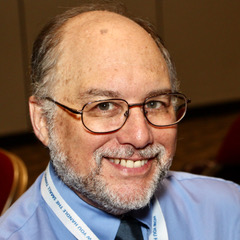
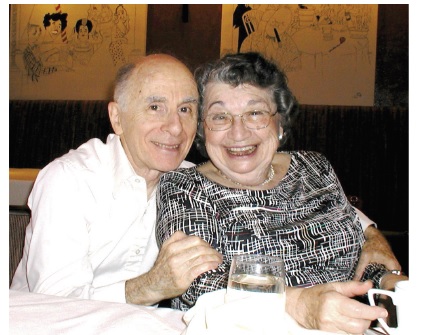
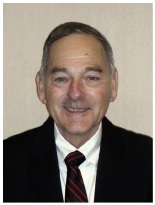
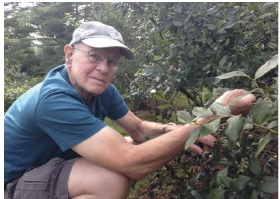
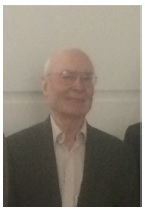

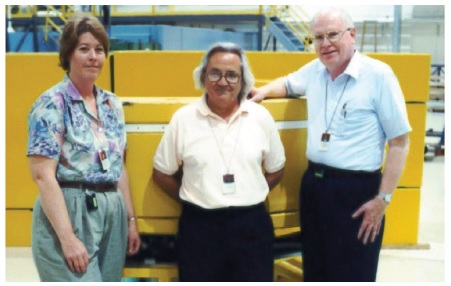
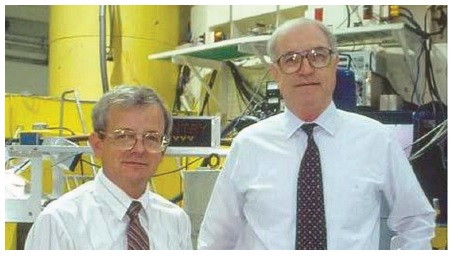 Mike Rowe and Jack Rush.
Mike Rowe and Jack Rush.